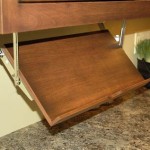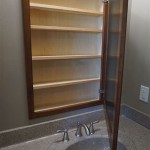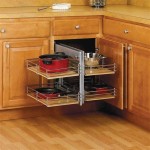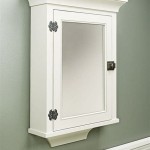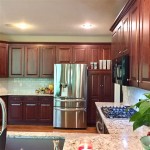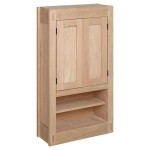How To Get Grease And Grime Off Kitchen Cabinets
Kitchen cabinets, particularly those near the stove, are magnets for grease, grime, and food splatters. Over time, these build-ups can become stubborn and unsightly, detracting from the overall appearance of the kitchen. Regular cleaning is crucial to maintain the cabinets' longevity and aesthetic appeal. This article details effective methods and solutions for removing grease and grime from kitchen cabinets, providing a comprehensive guide to achieving a clean and refreshed kitchen space.
The accumulation of grease and grime on kitchen cabinets is primarily due to cooking activities. Airborne grease particles released during frying, sautéing, and other cooking processes settle on the cabinet surfaces. These particles then trap dust, food residue, and other airborne contaminants, creating a sticky and often hardened layer. Cabinets located close to the stove are particularly vulnerable due to their proximity to the source of grease and splatters. The frequency and type of cooking heavily influence the extent of grease and grime build-up; households that cook frequently or engage in high-heat cooking methods will likely experience more significant accumulation.
Ignoring grease and grime build-up can lead to several negative consequences. Firstly, the accumulated layer becomes more difficult to remove over time as it hardens and bonds more strongly to the cabinet surface. This requires more intensive cleaning methods and may even necessitate the use of harsher chemicals. Secondly, the build-up can attract pests such as insects and rodents, creating unsanitary conditions in the kitchen. Thirdly, certain types of grime, particularly those containing acids or corrosive substances, can damage the cabinet finish, leading to discoloration, peeling, or even structural damage. Routine cleaning is therefore essential not only for aesthetic purposes but also for maintaining the integrity of the kitchen cabinets.
Preparing for Cleaning
Before commencing the cleaning process, it is imperative to gather the necessary supplies and prepare the work area. This preparation helps ensure a smooth and efficient cleaning session, minimizing potential messes and maximizing effectiveness. The required supplies generally include cleaning solutions, cloths or sponges, a scrubbing brush (optional), a spray bottle (optional), and protective gear such as gloves.
The first step is to gather the appropriate cleaning supplies. Several commercial cleaning products are specifically formulated for removing grease and grime from kitchen surfaces. These products often contain degreasing agents and solvents that effectively break down the oily residue. Alternatively, several readily available household ingredients can be used to create effective cleaning solutions. These include dish soap, baking soda, vinegar, and lemon juice. The choice of cleaning solution depends on the severity of the grime and the type of cabinet finish. For heavily soiled cabinets, a stronger commercial degreaser may be necessary, while for lightly soiled cabinets, a mild solution of dish soap and water may suffice.
A selection of cloths or sponges is also essential. Microfiber cloths are particularly effective at trapping dirt and grime without leaving streaks or residue. Soft sponges can also be used, but abrasive sponges should be avoided as they can scratch or damage the cabinet finish. A scrubbing brush with soft bristles can be helpful for tackling stubborn grime in hard-to-reach areas. However, it is crucial to use a brush with soft bristles to avoid scratching the cabinet surface.
Depending on the cleaning solution used, a spray bottle may be necessary for easy application. This allows for even distribution of the solution and prevents oversaturation of the cabinet surface. Finally, it is advisable to wear protective gloves to protect the skin from harsh cleaning chemicals. This is especially important when using commercial degreasers or solutions containing strong acids or bases.
Once the supplies are gathered, preparing the work area is the next step. This involves removing any items from the countertops below the cabinets to prevent them from getting wet or soiled. Covering the countertops with a drop cloth or old towels can also help protect them from spills and drips. If using a spray bottle, it is essential to ensure adequate ventilation in the kitchen. Opening windows or turning on the exhaust fan can help prevent the build-up of fumes from the cleaning solution.
Effective Cleaning Solutions
The selection of the appropriate cleaning solution is paramount to successfully removing grease and grime from kitchen cabinets. Various options are available, ranging from readily available household ingredients to specialized commercial degreasers. The ideal solution depends on the severity of the grime, the type of cabinet finish, and individual preferences regarding natural versus chemical-based cleaners.
A classic and versatile cleaning solution is a mixture of dish soap and warm water. Dish soap contains surfactants that effectively cut through grease and lift away dirt. To prepare this solution, simply add a few drops of dish soap to a basin of warm water. Stir the solution until it is well combined. This solution is gentle enough for most cabinet finishes and is particularly effective for removing light to moderate grime.
Baking soda is another effective and readily available household cleaner. Its mild abrasive properties help to scrub away stubborn grime without scratching most surfaces. To use baking soda, create a paste by mixing it with a small amount of water. Apply the paste to the grimy areas and gently scrub with a soft cloth or sponge. Rinse thoroughly with clean water and dry the surface. For particularly tough grime, baking soda can be mixed with dish soap and water to create a more potent cleaning solution.
Vinegar, a natural acid, is also an effective degreaser and disinfectant. It can dissolve grease and grime and kill bacteria. To use vinegar, dilute it with water in a 1:1 ratio. This solution can be applied to the cabinets using a spray bottle or a cloth. Allow the solution to sit for a few minutes to loosen the grime, then wipe clean with a damp cloth. The smell of vinegar can be strong, but it dissipates quickly. To mask the odor, a few drops of essential oil, such as lemon or lavender, can be added to the solution.
For more stubborn grime, a solution of ammonia and water can be used. Ammonia is a strong degreaser, but it should be used with caution as it can be irritating to the skin and respiratory system. Always wear gloves and ensure adequate ventilation when using ammonia. Dilute ammonia with water in a ratio of 1:10. Apply the solution to the cabinets with a cloth or sponge, and rinse thoroughly with clean water. Never mix ammonia with bleach, as this can create toxic fumes.
Several commercial degreasers specifically formulated for kitchen surfaces are available. These products often contain powerful solvents and surfactants that effectively remove grease and grime. When using commercial degreasers, it is essential to follow the manufacturer's instructions carefully. Wear gloves and ensure adequate ventilation. Test the product on an inconspicuous area of the cabinet before applying it to the entire surface to ensure that it does not damage the finish.
Cleaning Techniques and Tips
The success of removing grease and grime from kitchen cabinets relies not only on the cleaning solution but also on the cleaning techniques employed. Proper application, scrubbing, and rinsing techniques can significantly enhance the effectiveness of the cleaning process and prevent damage to the cabinet finish. Furthermore, incorporating specific tips and tricks can address common challenges and ensure a thorough clean.
Regardless of the cleaning solution used, the first step is to apply it evenly to the cabinet surface. This can be done using a spray bottle or a cloth. When using a spray bottle, hold it at a distance of approximately 6-8 inches from the cabinet surface and spray evenly. When using a cloth, dampen it with the cleaning solution and wipe the cabinet surface in a circular motion. Avoid oversaturating the cabinet surface, as this can cause water damage, particularly to wood cabinets.
After applying the cleaning solution, allow it to sit for a few minutes to loosen the grime. The duration depends on the severity of the grime and the type of cleaning solution used. For light grime, 2-3 minutes may be sufficient. For heavier grime, 5-10 minutes may be necessary. Avoid allowing the cleaning solution to dry on the cabinet surface, as this can leave streaks or residue.
Once the cleaning solution has had time to work, gently scrub the cabinet surface with a soft cloth or sponge. For stubborn grime, a scrubbing brush with soft bristles can be used. Apply moderate pressure and scrub in a circular motion. Avoid using excessive force, as this can scratch or damage the cabinet finish. Pay particular attention to areas where grease and grime tend to accumulate, such as around knobs, handles, and hinges.
After scrubbing, thoroughly rinse the cabinet surface with clean water. This is essential to remove any remaining cleaning solution and grime. Use a clean, damp cloth to wipe the cabinet surface. Change the water frequently to prevent re-depositing dirt and grime. Ensure that all traces of the cleaning solution are removed, as this can leave a sticky residue that attracts more dirt.
Finally, dry the cabinet surface with a clean, dry cloth. This helps to prevent water spots and streaks. Use a soft, absorbent cloth, such as a microfiber cloth. Wipe the cabinet surface in a circular motion until it is completely dry. For wood cabinets, drying along the grain can help to enhance the natural beauty of the wood.
For particularly stubborn grime, consider using a steam cleaner. Steam cleaners use hot steam to loosen and dissolve grease and grime. They are particularly effective for cleaning hard-to-reach areas, such as crevices and corners. When using a steam cleaner, follow the manufacturer's instructions carefully. Test the steam cleaner on an inconspicuous area of the cabinet before applying it to the entire surface to ensure that it does not damage the finish.
To prevent future build-up of grease and grime, consider applying a protective coating to the cabinet surface. Several commercial cabinet polishes and waxes are available that can help to repel dirt and grease. These products create a barrier between the cabinet surface and the airborne contaminants, making it easier to clean in the future. Follow the manufacturer's instructions carefully when applying these products.
Regular maintenance is also crucial for preventing the build-up of grease and grime on kitchen cabinets. Wipe down the cabinets regularly with a damp cloth to remove any fresh spills or splatters. This prevents them from hardening and becoming more difficult to remove later. Aim to wipe down the cabinets at least once a week, or more frequently if you cook frequently.

How To Clean Kitchen Cabinets Everyday Skate

Get Grease Off Kitchen Cabinets Easy And Naturally

How To Remove Grease From Kitchen Cabinets 3 Methods Bob Vila

How To Clean Sticky Grease Off Kitchen Cabinets Ovenclean

3 Ways To Clean Greasy Kitchen Cabinets Wikihow

How To Clean Grimy Kitchen Cabinets With 2 Ingredients

Clean Kitchen Cabinets Off With These Tips And Hints

Get Grease Off Kitchen Cabinets Easy And Naturally

Degrease Kitchen Cabinets With An All Natural Homemade Cleaner

How To Clean Kitchen Cabinets In A Few Easy Steps Hunker Cleaners Homemade House Cleaning Tips
Related Posts

